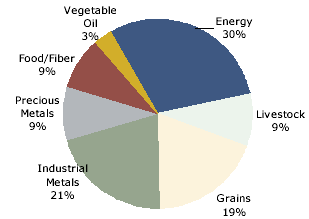
 Since Election Day, when the correction in equities started accelerating in earnest, commodities have outperformed stocks. Today let’s look at why this trend looks set to continue, and an easy way to potentially capture commodities’ next move.
Since Election Day, when the correction in equities started accelerating in earnest, commodities have outperformed stocks. Today let’s look at why this trend looks set to continue, and an easy way to potentially capture commodities’ next move.
Commodities enjoyed a nice rally last week, rising 2 percent on improving fiscal-cliff sentiment, a weaker U.S. dollar and dovish comments by multiple Federal Reserve governors, including Ben Bernanke. As of Monday’s close, commodities were 1 percent higher than the Election Day close, while equities remain multiple percentage points lower.
This confirms what I’ve been saying to my Million-Dollar Contrarian Portfolio subscribers about the equity-market correction.
It’s not about the potential for a fundamental downgrade in the global economic outlook or fears of another debt crisis. In that case, commodities would be weaker than stocks — like they were in May and June when Europe was the No. 1 macro concern.
Instead, the correction is being driven by big-money traders’ year-end performance worries and big-money investors’ feared tax increases.
The big economic data from last week confirmed this belief.
As China Goes, So Goes the World
The flash Purchasing Managers Index figures from the U.S., Europe and China all beat expectations. The numbers from China and Europe were really more-important than those from the United States, as there is ample evidence showing the U.S. economy is solidly in (albeit slow) growth mode.
The Chinese flash PMI broke above the critical 50 level that determines whether there is contraction or growth. It is now at a 13-month high, further suggesting the economically stimulating efforts of the past few months are continuing to take hold.
China’s growth accelerating remains an important positive catalyst for the global macro economy.
In Europe, the headline composite PMIs (which combine manufacturing and services) were little changed (up 0.01 to 45.8). But the devil’s in the details. And the report shows some reason for cautious optimism that the European economy may be starting to level off.
The manufacturing component of the European PMI rose 0.8 to 45.9, but I think what’s more important is the new orders component, which rose 0.9 to 44.1. Other details of the manufacturing PMI suggested future increases as well, including low inventory levels.
This bigger picture is particularly important to watch right now. Although the U.S. stock markets are concerned about the fiscal cliff and a decline into year-end, the global macro economy is actually showing signs of bottoming. And, in the case of China, it shows accelerating growth.
You might have also heard the saying, “As China goes, so go commodities.” With both on the rise, both can be a timely play. However, I’m keeping a closer eye on commodities, and here’s one way you can do the same.
Slow Growth Is Still Growth;
Here’s One Way to Take Advantage
U.S. political gridlock has halted a rise in equities. But commodities trading, which is more heavily influenced by growth or contraction in the global economy, has been rising as prospects appear to be improving.
And I think the easiest way for investors to add commodities to their portfolio is through the Power Shares Deutsche Bank Commodity Index Tracking Fund (DBC), an ETF that provides exposure to major commodity groups including metals, energy and agriculture.
While I expect the U.S. markets to continue to be held hostage by fiscal-cliff negotiations between now and the end of the year, incredibly accommodative monetary policy unleashed across the globe appears to finally be working.
And if that trend continues, commodities will be some of the largest beneficiaries.
Best,
Tom
About Tom Essaye
Tom Essaye began his financial services career at Merrill Lynch’s Corporate and Investment Banking group. During that time he worked on the junk bond, syndicated loan, and domestic equity trading desks. Then Tom joined the firm’s U.S. Listed Equity desk, where he traded equities for clients on the floor of the New York Stock Exchange. While on the floor Tom managed multi-million dollar equity trades from some of the world’s largest hedge and mutual funds.
When Tom recognized a unique fundamental investment opportunity in the natural resource markets, he co-founded a natural resource and commodity focused hedge fund. He served as the director of trading and investor relations, where he executed the fund’s equity and commodity futures trades.
He spent the final two years at the fund as manager of the energy portion of the portfolio, which totaled one-third of the fund’s assets. Additionally, through his entire tenure at the fund, Tom represented the fund at investor and industry conferences.
Tom has held the position of Vice President of Investment Services at Weiss Research, and now he manages the company’s Million-Dollar Contrarian Portfolio.
Tom is a cum laude graduate from Vanderbilt University with a major in business management and minors in finance and philosophy. And he received his MBA from the Hough Graduate School of Business at the University of Florida.
2013: The Next Move for Stocks …
The Fed has cranked the printing press into overdrive … filling the economy with $40 billion a month to buoy the markets — all in a desperate effort to keep investors at ease. But it can’t last forever.
Will 2013 be the year we see inflation take the stock market to the moon … or will global investors finally cut their ties and send the markets into freefall?
This is the most important question for Americans right now … and getting the right answer can make you profits hand over fist in 2013. Share your opinion with us and get a $49 gift just for answering.












